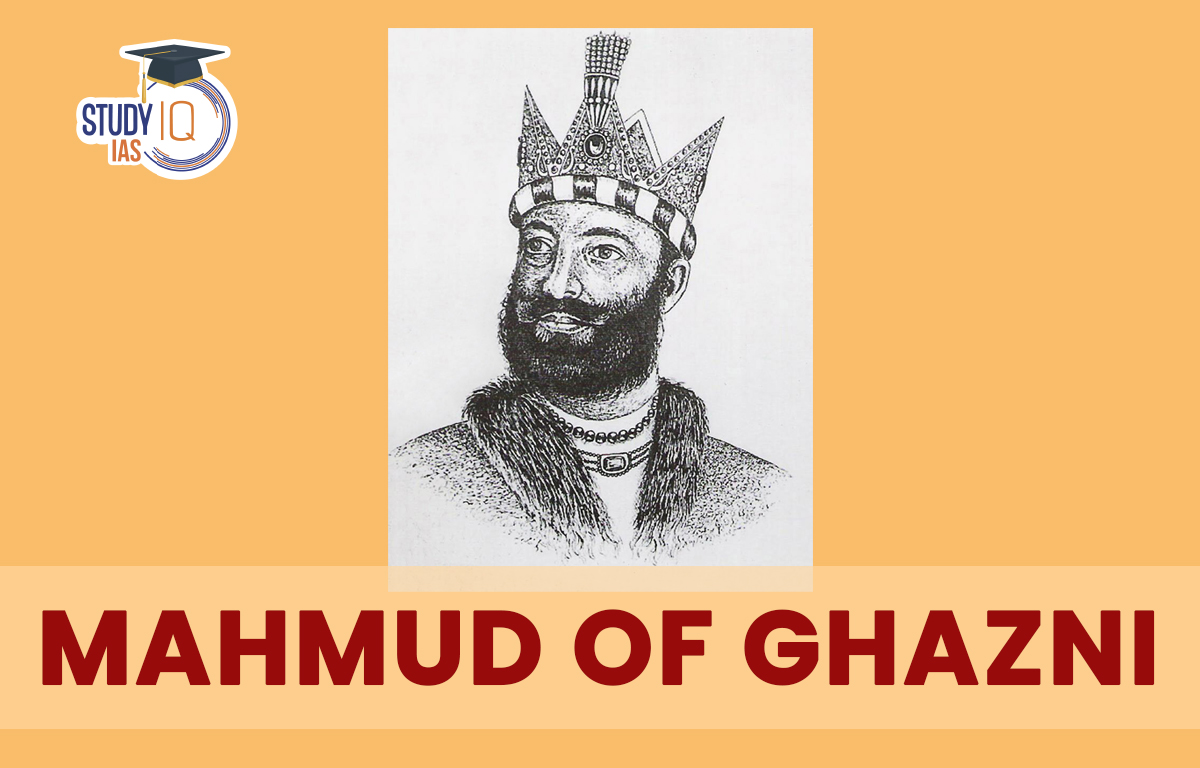Table of Contents
Mahmud of Ghazni
The Turkic Ghaznavid dynasty was established by Mahmud of Ghazni (971–1030), and it governed from 998 to 1030. By the time of his death, his realm had developed into a sizable military empire that spanned from northwest Iran itself to Punjab in India, Khwarazm in Transoxiana, and Makran. Mahmud of Ghazni (971–1030) will be discussed in this article, which will be useful for UPSC exam preparation. This article has all the details about Mahmud of Ghazni one of the important topics in medieval history Subject of UPSC Syllabus.
Mahmud of Ghazni History
The Turks invaded India after the Arabs seized control of Sindh in the eleventh century. Islam is believed to have been introduced to India by the Turks. Amir-Abu-Bakr Lawik, the monarch of the Samanid dynasty, owned the Trukish slave Alptigin, who established the Ghaznivid dynasty in 963. He seized control of the Jabul kingdom, which had Ghazni as its center. He was replaced by his competent and aspirational son-in-law, Subuktigin. He was effective in overthrowing Hindushahi ruler Jayapala in every region between Lamghan and Peshawar.
The Hindushahi kingdom was unable to restrain the Ghaznavids’ expanding power in the east as a consequence. But his attacks had no lasting effect. Ismail, who was overthrown by his brother Mahmud in 998, replaced Subuktigin as ruler. His most famous historical persona is Mahmud of Ghazni.
Also Read: Decline of Mughal Empire
Mahmud of Ghazni Biography
Muhammad Yamin ad-Dawlah Mahmud of Ghazni, also known as Mahmud ibn Sebuktigin, came from modest origins. Mahmud, who was the son of a Turkish concubine, ascended to power in Ghazna in 998. He also made history’s first use of the term “sultan,” which would come to be employed centuries after his passing.
The Ghaznavid family continued to grow during Mahmud’s rule. Mahmud built libraries, mosques, and palaces because he had great regard for men who had an education. As a result, his capital city gained a reputation as the jewel of Central Asia and drew numerous esteemed academics to settle there. Asian Muslims were led by none greater than Mahmud of Ghazni. He loved books and art, as well as thinkers like Firdausi and Alberuni.
While some consider him an Islamic hero, others consider him to have desecrated Buddhist, Jain, and Hindu temples. He permanently changed the politics, religion, and society of the Indian Subcontinent by imposing Muslim rule over a sizable portion of it.
Also Read: Nadir Shah Invasion
Mahmud of Ghazni Early Life
Muhammad Yamin ad-Dawlah In the province of Ghazna, Mahmud ibn Sebuktigin was born on November 2, 971. The current site of this city is in southeast Afghanistan. Mahmud was Sebuktigin’s and his second wife’s eldest child. Turkic warrior Sebuktigin, formerly a slave from Ghazni, wed the daughter of his erstwhile master, the governor of Ghazni.
Sebuktigin took possession of Ghazna and started capturing other significant Afghan cities as the Samanid dynasty, the nation’s ruling family, began to fall. Sebuktigin, who was dying, gave his authority to his son Ismail, his first wife’s child and Mahmud’s younger sibling.
Mahmud of Ghazni Famous Poet
Famous Poet Patronized by Mahmud Ghazni were Firdausi who wrote shshnmah and Alberuni who wrote Kitab-i-hind.
Mahmood Ghaznavi Invasion of India
When Mahmud attacked Sistan and deposed Khalaf ibn Ahmad in 1002, the Saffarid dynasty came to an end. Mahmud Ghazni repeatedly invaded India in search of riches, and during the seventh invasion, he was located in Nagarkot in the Kangra region. Wealthy churches were common in that area. It is true that Mahmud of Ghazni’s people congregated to view India’s wealth after he returned from this invasion bearing so much jewellery, wealth, gold, and silver.
Mahmud of Ghazni’s attacks had a significant impact on Indian citizens in a number of ways. The expansion of the empire and the abolition of the Rajputs and Shahis were the after-invasion repercussions that the people of India had to deal with as a result of the Mahmud Ghazni invasions.
Thousands of soldiers were also slain by him, many of whom had been purchased as slaves. The following assaults by Ghazni left the survivors without the drive to defend themselves. He was primarily responsible for the destruction of much of the temple buildings and art in India. Few individuals were made to convert to Islam against their will, which helped the Mughal Dynasty establish itself in India.
Also Read: Muhammad Shah
Mahmud of Ghazni Invasion of India Reason
Mahmud of Ghazni was attracted to India’s vast wealth. As a consequence, he frequently conducted raids in India. He invaded India with a religious component as well. He destroyed the shrines of Somnath, Kangra, Mathura, and Jwalamukhi, earning the nickname “Idol Breaker.”
Mahmud Ghazni and Somnath Attack
Mahmud invaded Gujarat in 1025, plundering the Somnath shrine and destroying its jyotirlinga. His loot included 2 million dinars. Somnath was conquered, and Anhilwara was invaded as retaliation. Some historians claim that there are records of temple visits in 1038 that do not reference any damage to the structure. But strong, intricately detailed legends about Mahmud’s raid had emerged in Turko-Persian literature, which, in the words of researcher Meenakshi Jain, “electrified” the Muslim world.
Mahmud’s final invasion of Gujarat took place in 1025–1026 CE, and he solidified his gains by robbing the incredibly rich Somnath temple. There would allegedly always be 100,000 pilgrims present, 1,000 Brahmanas serving the temple and caring for its treasures, and hundreds of dancers and vocalists entertaining the crowd in front of the temple’s gates. In the garbhagriha was the well-known Linga, a pillar-stone covered in brilliant jewels and lit gem candelabra.
When the temple gates at Ghazni were opened, the invader-troop plunderers who had accompanied him on his vengeful journeys to India and beyond got a reward of one million pounds’ value of treasure. Because of the destruction of Somnath, Mahmud of Ghazni was revered for nearly nine centuries as a forerunner of the Islamic religion who opposed the Hindu belief system.
Also Read: Later Mughals
Mahmud of Ghazni Rules Ends in India
Mahmud of Ghazni’s successors governed the Ghaznavid Empire for 157 years. The bulk of the western Ghaznavid territory was absorbed by the Seljuk Empire.
The last Ghaznavid bastion, Lahore, was conquered by Mu’izz al-Din (also known as Muhammad of Ghori) in 1187 after the Ghorids had taken Ghazni in 1150. Mahmud was a brilliant military leader, but he was unable to subtly secure his empire’s gains. Mahmud also lacked competent leadership during his reign and was unable to create lasting organizations in his state.
Mahmud of Ghazni Death
At the age of 58, Sultan Mahmud of Ghazni passed away in Ghazni on April 30, 1030. Malaria had struck Sultan Mahmud during his previous expedition. Malaria-related medical complications had led to fatal TB (tuberculosis).
Mahmud of Ghazni UPSC
Mahmud of Ghazni was a valiant fighter with outstanding tactical and strategic skills. He had expanded the modest state of Ghazna/Ghazni/Ghaznin into a massive and thriving empire that included the majority of contemporary Afghanistan, eastern Iran, and the northwestern regions of the Indian subcontinent. He was a patron of Persian writing in the Ghaznavid Empire in addition to his martial prowess. To know all the important information related to UPSC preparation candidates can visit the official website of StudyIQ UPSC Online Coaching.


 Indus River System, Tributaries, and Sin...
Indus River System, Tributaries, and Sin...
 Jallianwala Bagh Massacre, Date, History...
Jallianwala Bagh Massacre, Date, History...
 Important Lakes of India, State wise and...
Important Lakes of India, State wise and...






















